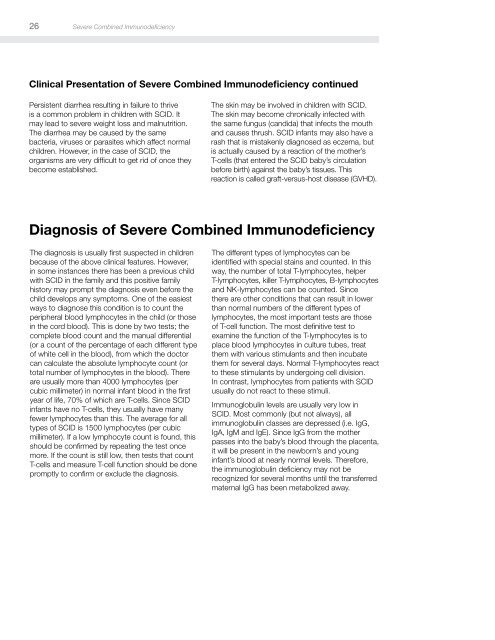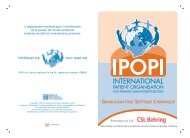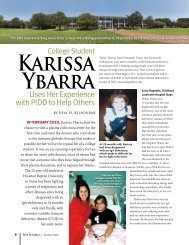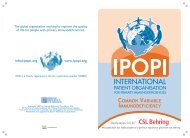IDF Patient & Family Handbook for Primary Immunodeficiency ... - IDFA
IDF Patient & Family Handbook for Primary Immunodeficiency ... - IDFA
IDF Patient & Family Handbook for Primary Immunodeficiency ... - IDFA
Create successful ePaper yourself
Turn your PDF publications into a flip-book with our unique Google optimized e-Paper software.
26<br />
Severe Combined <strong>Immunodeficiency</strong><br />
Clinical Presentation of Severe Combined <strong>Immunodeficiency</strong> continued<br />
Persistent diarrhea resulting in failure to thrive<br />
is a common problem in children with SCID. It<br />
may lead to severe weight loss and malnutrition.<br />
The diarrhea may be caused by the same<br />
bacteria, viruses or parasites which affect normal<br />
children. However, in the case of SCID, the<br />
organisms are very difficult to get rid of once they<br />
become established.<br />
The skin may be involved in children with SCID.<br />
The skin may become chronically infected with<br />
the same fungus (candida) that infects the mouth<br />
and causes thrush. SCID infants may also have a<br />
rash that is mistakenly diagnosed as eczema, but<br />
is actually caused by a reaction of the mother’s<br />
T-cells (that entered the SCID baby’s circulation<br />
be<strong>for</strong>e birth) against the baby’s tissues. This<br />
reaction is called graft-versus-host disease (GVHD).<br />
Diagnosis of Severe Combined <strong>Immunodeficiency</strong><br />
The diagnosis is usually first suspected in children<br />
because of the above clinical features. However,<br />
in some instances there has been a previous child<br />
with SCID in the family and this positive family<br />
history may prompt the diagnosis even be<strong>for</strong>e the<br />
child develops any symptoms. One of the easiest<br />
ways to diagnose this condition is to count the<br />
peripheral blood lymphocytes in the child (or those<br />
in the cord blood). This is done by two tests; the<br />
complete blood count and the manual differential<br />
(or a count of the percentage of each different type<br />
of white cell in the blood), from which the doctor<br />
can calculate the absolute lymphocyte count (or<br />
total number of lymphocytes in the blood). There<br />
are usually more than 4000 lymphocytes (per<br />
cubic millimeter) in normal infant blood in the first<br />
year of life, 70% of which are T-cells. Since SCID<br />
infants have no T-cells, they usually have many<br />
fewer lymphocytes than this. The average <strong>for</strong> all<br />
types of SCID is 1500 lymphocytes (per cubic<br />
millimeter). If a low lymphocyte count is found, this<br />
should be confirmed by repeating the test once<br />
more. If the count is still low, then tests that count<br />
T-cells and measure T-cell function should be done<br />
promptly to confirm or exclude the diagnosis.<br />
The different types of lymphocytes can be<br />
identified with special stains and counted. In this<br />
way, the number of total T-lymphocytes, helper<br />
T-lymphocytes, killer T-lymphocytes, B-lymphocytes<br />
and NK-lymphocytes can be counted. Since<br />
there are other conditions that can result in lower<br />
than normal numbers of the different types of<br />
lymphocytes, the most important tests are those<br />
of T-cell function. The most definitive test to<br />
examine the function of the T-lymphocytes is to<br />
place blood lymphocytes in culture tubes, treat<br />
them with various stimulants and then incubate<br />
them <strong>for</strong> several days. Normal T-lymphocytes react<br />
to these stimulants by undergoing cell division.<br />
In contrast, lymphocytes from patients with SCID<br />
usually do not react to these stimuli.<br />
Immunoglobulin levels are usually very low in<br />
SCID. Most commonly (but not always), all<br />
immunoglobulin classes are depressed (i.e. IgG,<br />
IgA, IgM and IgE). Since IgG from the mother<br />
passes into the baby’s blood through the placenta,<br />
it will be present in the newborn’s and young<br />
infant’s blood at nearly normal levels. There<strong>for</strong>e,<br />
the immunoglobulin deficiency may not be<br />
recognized <strong>for</strong> several months until the transferred<br />
maternal IgG has been metabolized away.
















